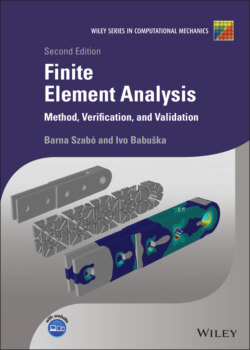Читать книгу Finite Element Analysis - Barna Szabó - Страница 38
Indirect computation of in node points
ОглавлениеThe first derivative in node points can be determined indirectly from the generalized formulation. For example, to compute the first derivative at node xk from the finite element solution, we select and use
(1.86)
Test functions used in post‐solution operations for the computation of a functional are called extraction functions. Here is an extraction function for the functional . This is because and and hence
(1.87)
where, by definition; .
Example 1.8 Let us find for the problem in Example 1.7 by the direct and indirect methods. In this case the exact solution is known from which we have . By direct computation:
and by indirect computation:
Example 1.9 The following example illustrates that the indirect method can be used for obtaining the QoI efficiently and accurately even when the discretization was very poorly chosen. We will consider the problem
where δ is the delta function, see Definition A.5 in the appendix. Let us be interested in finding the approximate value of . The data are and . We will use one finite element and This is a poorly chosen discretization because the derivatives of u are discontinuous in the point , whereas all derivatives of the shape functions are continuous. The proper discretization would have been to use two or more finite elements with a node point in . Then the exact solution would be obtained at .
If we use the Legendre shape functions then the coefficient matrix displayed in eq. (1.66) will be perfectly diagonal. The first two rows and columns will be zero on account of the boundary conditions and the diagonal term will be 2. Referring to eq. (1.75) the right hand side vector will be
Therefore the coefficients of the shape functions can be written as () where the variables are renumbered through shifting the indices to account for the boundary conditions: . Hence
and the QoI is:
From the definition of Ni in eq. (1.53) we have
and the QoI can be written as
where we made use of eq. (1.55). The relationships between the polynomial degree ranging from 2 to 100 and the corresponding values of the QoI computed by the direct method are displayed in Fig. 1.7. It is seen that convergence to the exact value is very slow.
The indirect method is based on eq. (1.18) which, applied to this example, takes the form
Selecting and rearranging the terms we get
Figure 1.7 Example 1.9. Values of computed by the direct method.
which is the exact solution. The choice was exceptionally fortuitous because it happens to be the Green's function (also known as the influence function) for . Therefore the extracted value is independent of the solution .
Let us choose for the extraction function. In this case
Substituting for :
Taking the orthogonality of the Legendre polynomials (see eq. (D.13)) into account, the sum has to be evaluated only for . The extracted value of for is (31.25% error).
An explanation of why the extraction method is much more efficient than direct computation is given in Section 1.5.4.
Exercise 1.16 Find for the problem in Example 1.7 by the direct and indirect methods. Compute the relative errors.
Exercise 1.17 For the problem in Example 1.9 let be the extraction function. Calculate the extracted value of for .
